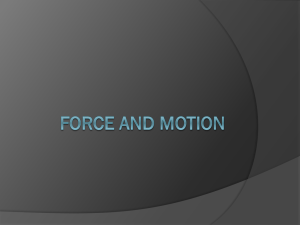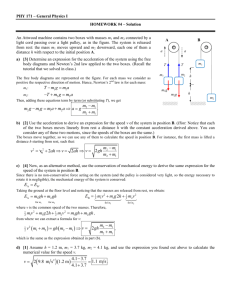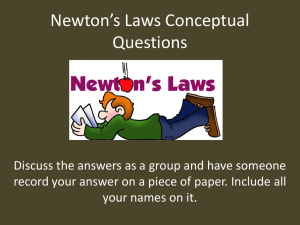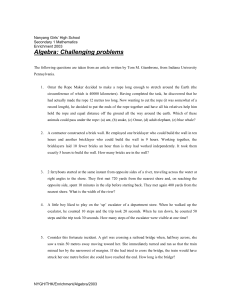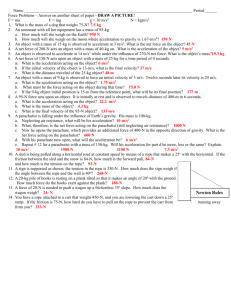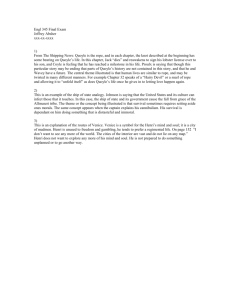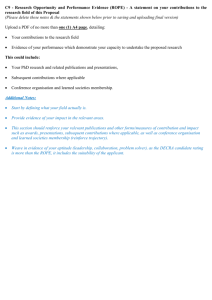Chapter 5
advertisement
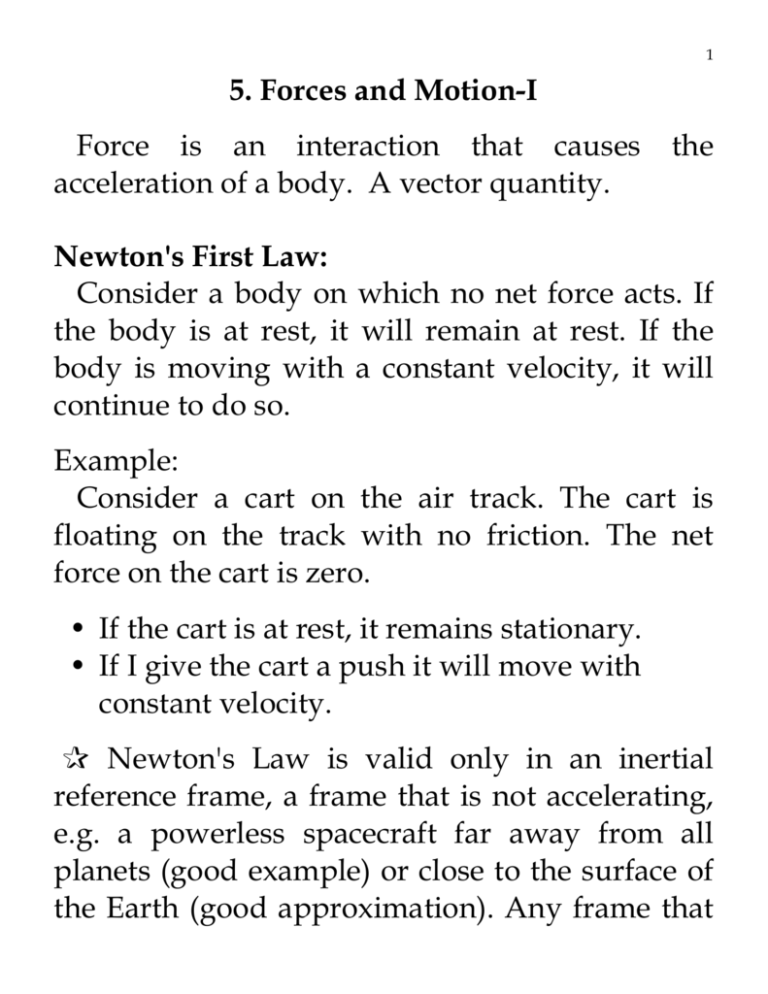
1 5. Forces and Motion-I Force is an interaction that causes acceleration of a body. A vector quantity. the Newton's First Law: Consider a body on which no net force acts. If the body is at rest, it will remain at rest. If the body is moving with a constant velocity, it will continue to do so. Example: Consider a cart on the air track. The cart is floating on the track with no friction. The net force on the cart is zero. • If the cart is at rest, it remains stationary. • If I give the cart a push it will move with constant velocity. P Newton's Law is valid only in an inertial reference frame, a frame that is not accelerating, e.g. a powerless spacecraft far away from all planets (good example) or close to the surface of the Earth (good approximation). Any frame that 2 is moving at constant velocity with respect to an inertial frame is also an inertial frame. Mass: • Some objects require more force to change their current state than others, e.g. it is easier to push a chair than a car. • The tendency for an object to remain in its current state is called inertia, and mass is a quantitative measure of that tendency. • Mass is not the same as weight, the gravitational attraction on an object, which depends on the distance from the center of the Earth. • Mass is an intrinsic quantity of an object that characterizes how an object responds to a force. • Unit: kilogram (kg) Newton's Second Law: The acceleration is related to the net force via a proportionality constant: r 3 r ∑ F = ma ∑ Fx = max ∑ Fy = may ∑ Fz = maz • Acceleration along one direction is caused by a net force along that direction, independent of the forces in the other directions. • The summation is over the external forces, excluding forces between different parts of the object (internal forces). • Relation between force and acceleration holds for each direction separately. • Unit: Newton (N = kg ⋅ m / s2 ) Example: Three kids are pushing a box across a floor. Two kids are pushing to the right, one with a force of 100 N and the other with a force of 200 4 N. Another kid is pushing to the left with a force of 300 N. The mass of the box is 50 kg. What is the acceleration of the box? 100 N 200 N 300 N x ∑ Fx = ma 100 N + 200 N - 300 N = ma 0 = ma a=0 Example: A 10,000-kg box initially at rest is given a force of 500 N on one side and a force of 1000 N on the other side as shown. What is the displacement of the box after the force has been applied for 10 s? y r t = 10 s r=? F = 1000 N y t=0 v0 = 0 F = 500 N x x ∑ Fx = max ax = ∑ Fx m 500 N = 10000 kg = 0.05 m / s2 ∑ Fy = ma y ay = ∑ Fy m 1000 N = 10000 kg = 0.1 m / s2 x = x0 + v0 x t + 12 ax t 2 = 12 ax t 2 = 12 (0.05 m / s 2 )(10 s) 2 = 2.5 m 5 6 y = y0 + v0 y t + 12 ay t 2 = 12 ay t 2 = 12 (0.1 m / s2 )(10 s) 2 = 5.0 m r = x 2 + y2 2 2 = (2.5 m ) + (5.0 m) = 5.6 m Conceptual Questions: (a) A constant force is exerted on a cart initially at rests on an air track with negligible friction. The force acts for a short time interval to give the cart a certain final speed. To reach the same final speed with a force that is only half as big, the force must be exerted for a time interval: 1. Four times as long 2. Twice as long 3. Equal 4. Half as long 7 5. Quarter as long (b) Instead of starting from rest, at the moment the force was applied, the cart is already moving with a constant speed in the direction of the force. After exerting the same constant force for the same short time interval, the increase in the cart's speed is: 1. Two times its initial speed 2. The square of its initial speed 3. Four times its initial speed 4. The same as when it started from rest 5. Cannot be determined from the information provided Some Specific Forces: • Will discuss four commonly known forces that act on an object. 8 rope T T N m f Fg Force of Gravity: • Attractive r r force between two objects: Fg = W = −mg ˆj where ˆj points upward and g = 9.8 m / s2 . Tension: • The force exerted by the pull of a rope (cable or string). • The direction is along the rope. • The rope is assumed to be massless (light) and unstretchable. • The rope may be passed through a pulley that is assumed to be massless (light) and frictionless (well-oiled). 9 Example: Fc Fc F r T Fr y T x mg What is T, Fr , and Fc? Apply Newton's 2nd Law on the mass: ∑ Fy = T − mg = 0 T = mg Since the tension is the same every place along the rope, Fr = T = mg 10 F c T T ∑ Fx = T − Fcx = 0 ⇒ Fc x = T = mg ∑ Fy = Fc y − T = 0 ⇒ Fc y = T = mg Fc = Fc2x + Fc2y = 2mg Fcy θ = tan = 45o Fcx −1 Friction: • The resistance between two surfaces when attempting to slide one object across the other. • Friction is always opposite to the direction of motion. 11 F F f f Normal Force: • Force exerted by a surface on an object. • The force is perpendicular (normal) to the surface. y y N N x x θ θ mg mg ∑ Fy = N − mg = 0 N = mg ∑ Fy = N − mg cosθ = 0 N = mg cosθ • Normal force may be less or greater than the weight. 12 Newton's Third Law: Whenever a body exerts a force on a second body, the second body exerts an oppositely directed force of equal magnitude on first body. i.e. for every action, there is an equal and opposite reaction. • 1st and 2nd Newton's Laws describe forces on a single body, while 3rd Law refers to a pair of forces acting on two different bodies. N ActionReaction Pair mg R Problem 48 (p. 105) Three blocks on a horizontal frictionless table are connected as shown and pulled to the right with a force T3 = 65.0 N. If m1 = 12.0 kg, m2 = 24.0 kg, and m3 = 31.0 kg, calculate (a) the acceleration, (b) the tensions T1 and T2. 13 x T1 m1 m2 N1 T2 m3 N3 N2 T1 T1 m1 g T2 T2 m2g = T1 = m1a (1) ∑ Fx = T2 − T1 = m2 a (2) ∑ Fx = T3 − T 2 = m3a (3) 2 3 Substitute (1) in (2), T2 = T1 + m2 a = m1a + m2 a Substitute in (3), T3 m3g ∑ Fx 1 T3 T3 = T 2 + m3 a = m1a + m2 a + m3a T3 a= m1 + m2 + m3 65.0 N = (12.0 + 24.0 + 31.0) kg = 0.97 m s 2 From (1), T1 = m1a = 12.0 × 0.97 = 11.6 N T 2 = T1 + m2 a = 11.6 + 24.0 × 0.97 = 34.9 N 3 If T3 = 0 ⇒ a = 0 ⇒ T1 = T2 = 0 3 If m2 = 0 ⇒ T1 = T 2 3 a can be determined as if we treat all three boxes as a single box with m = m1 + m2 + m3 Conceptual Question: 14 15 (a) rope T> 0 The normal force exerting on the block is: 1. > mg 2. < mg 3. = mg (b) Consider a person standing in an elevator that is accelerating upward. The upward normal force N exerted by the elevator floor on the person is 1. greater than the person’s weight 2. less than the person’s weight 3. the same as the person’s weight Problem 52 (p. 104) A 85-kg man lowers himself to the ground from a height of 10.0 m by holding onto a rope that runs over a frictionless pulley to a 65-kg sandbag. (a) With what speed does he hit the ground if he started from rest? (b) Is there 16 anything he could do to reduce the landing speed? free-body diagram: T T m1g m 2g y a man a sandbag (a) Need to calculate a: Man: m1g − T = m1a Sandbag: T − m2 g = m2 a (1) + (2) m1g − m2 g = (m1 + m2 )a (1) (2) m1 − m2 a= g m1 + m2 = 3 Unit: OK (85 − 65) kg × 9.8m s 2 (85 + 65) kg = 1.3m s 2 17 3 If m1 = m2 → a = 0 3 If m2 = 0 → a = g v 2 = v0 2 + 2a(y − y0 ) = 0 + 2a(h − 0) = 2ah v = 2ah = 2 × (1.3 m s2 ) × 10.0 m = 5.1 m s (b) Climb up to reduce v. Problem 57 (p.105) A 10-kg mass on a 370 incline is connected to a 3.0-kg mass on a horizontal surface. If there is no friction and F = 12 N, what is the tension in the rope? + m1 m2 T T θ F θ m1g 18 Box 1: Box 2: F − T − m1gsin θ = m1a T = m2 a T a= m2 m1 F − T − m1gsin θ = T m2 F − m1gsin θ T= m1 1+ m2 = 4.6 N 3 Unit: OK 3 If m2 = 0 → T = 0 Problem 59, (p.105): A worker tries to lower a bundle of old roofing material weighing 100 lbs to the ground with a rope that will snap if the tension exceeds 87 lbs. (a) How can he avoid snapping the rope? (b) If the descent is 20 ft and he is just barely avoid snapping the rope, at what speed will the bundle hit the ground? 19 T max = 87 lbs mg = 100 lbs + • The roofing material needs to descend a downward acceleration. mg − Tmax = mamin • larger acceleration ’ smaller tension 3 If a = g → T = 0 with 20 (a) amin T max =g− m 87 lbs =g− (100 lbs) / g 87 ) = g(1 − 100 87 ) = (32 ft / s 2 )(1 − 100 = 4.2 ft / s 2 (b) v 2 = v0 2 + 2a(y − y0 ) = 2ah v = 2ah = 2(4.2 ft / s 2 )(20 ft) = 13 ft s Example: Two masses hang from a frictionless and massless pulley system. If m1 = 6 kg and m2 = 10 21 kg, find the accelerations of each mass and tension in the rope. Pulley 1 Pulley 2 m1 m2 T T T F2 a F 2 a 1 2 m2g m g 1 • assume the heavier object is moving down Pulley 2: 2T − F2 = ma = 0 F2 = 2T Mass 2: m2 g − F2 = m2 a2 (1) Mass 1: m2 g − 2T = m2 a2 T − m1g = m1a1 T = m1g + m1a1 (2) 22 • 2 equations, but 3 unknowns P If pulley 1 goes up 1 cm pulley 2 goes down 0.5 cm a1 = +2a2 (3) Substitute (2) into (1) m2 g − 2m1a1 − 2m1g = m2 a2 By (3): m2 g − 4m1a2 − 2m1g = m2 a2 m2 − 2m1 g a2 = 4m1 + m2 = −0.58 m / s2 a1 = 2a2 = −1.2 m / s 2 From (2): T = m1a1 + m1g = 52 N • Both accelerations are negative, i.e. pulley 2 moves up and pulley 1 moves down, i.e. the lighter mass is pulling the heavier mass up! This is why cranes use many pulleys to lift heavy objects with small force. 23 Conceptual Question: (1) Consider a horse pulling a buggy. Do the weight of the horse and the normal force exerted by the ground on the horse constitute an interaction pair that are always equal and opposite according to Newton's 3rd Law? (a) yes (b) no (2) A 50-kg person stands on a 25-kg platform, as shown. If she pulls the platform up at a steady rate, with how much force is she pulling on the rope? Ignore friction and assume g = 10 m/s2. (c) Two people pull on a rope playing tug-ofwar. Each person pulls with a force of 400 N. What is the tension in the rope? 24 (1) 200 N (2) 400 N (3) 800 N (4) 0 N (They cancel each other)
